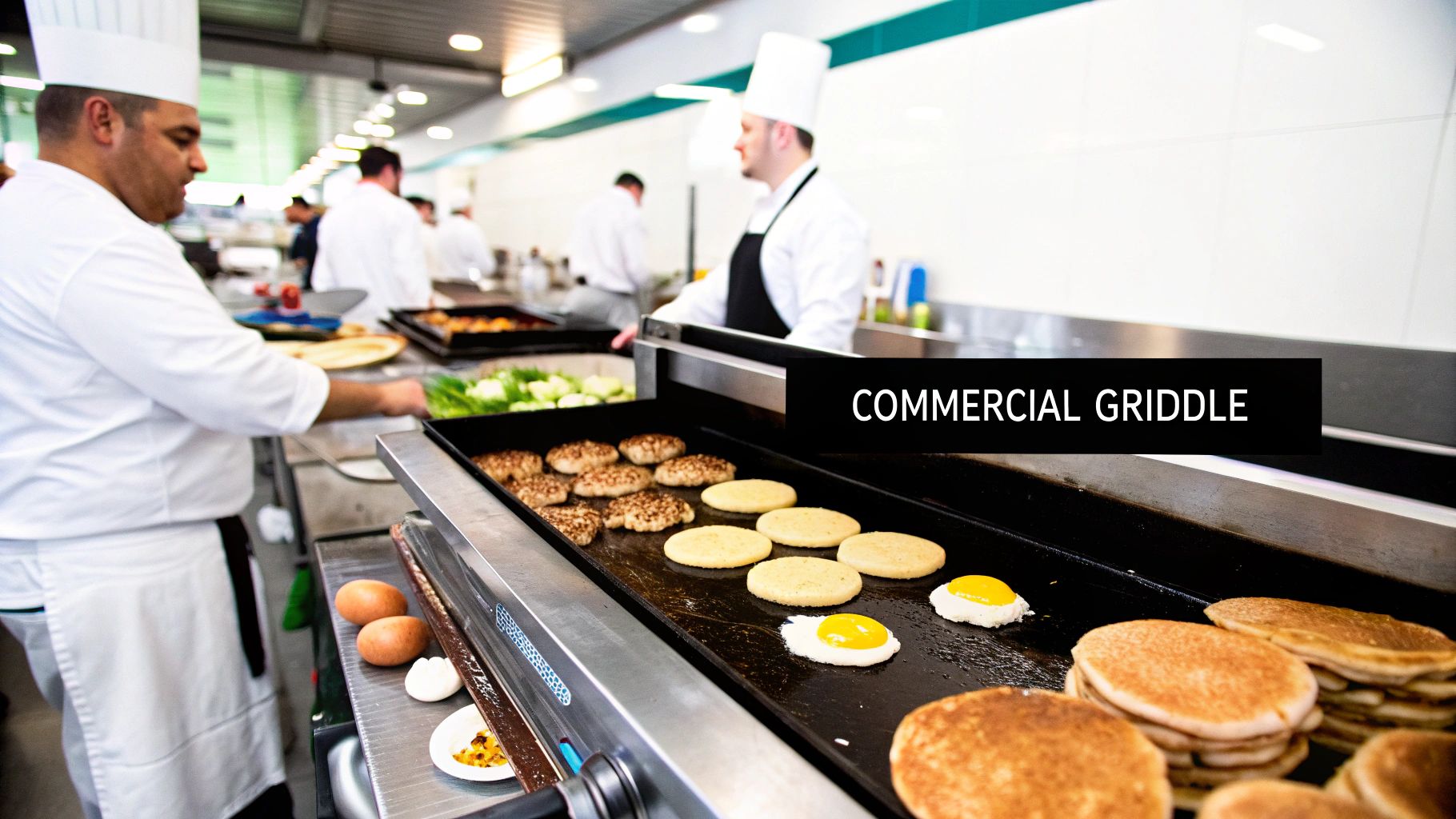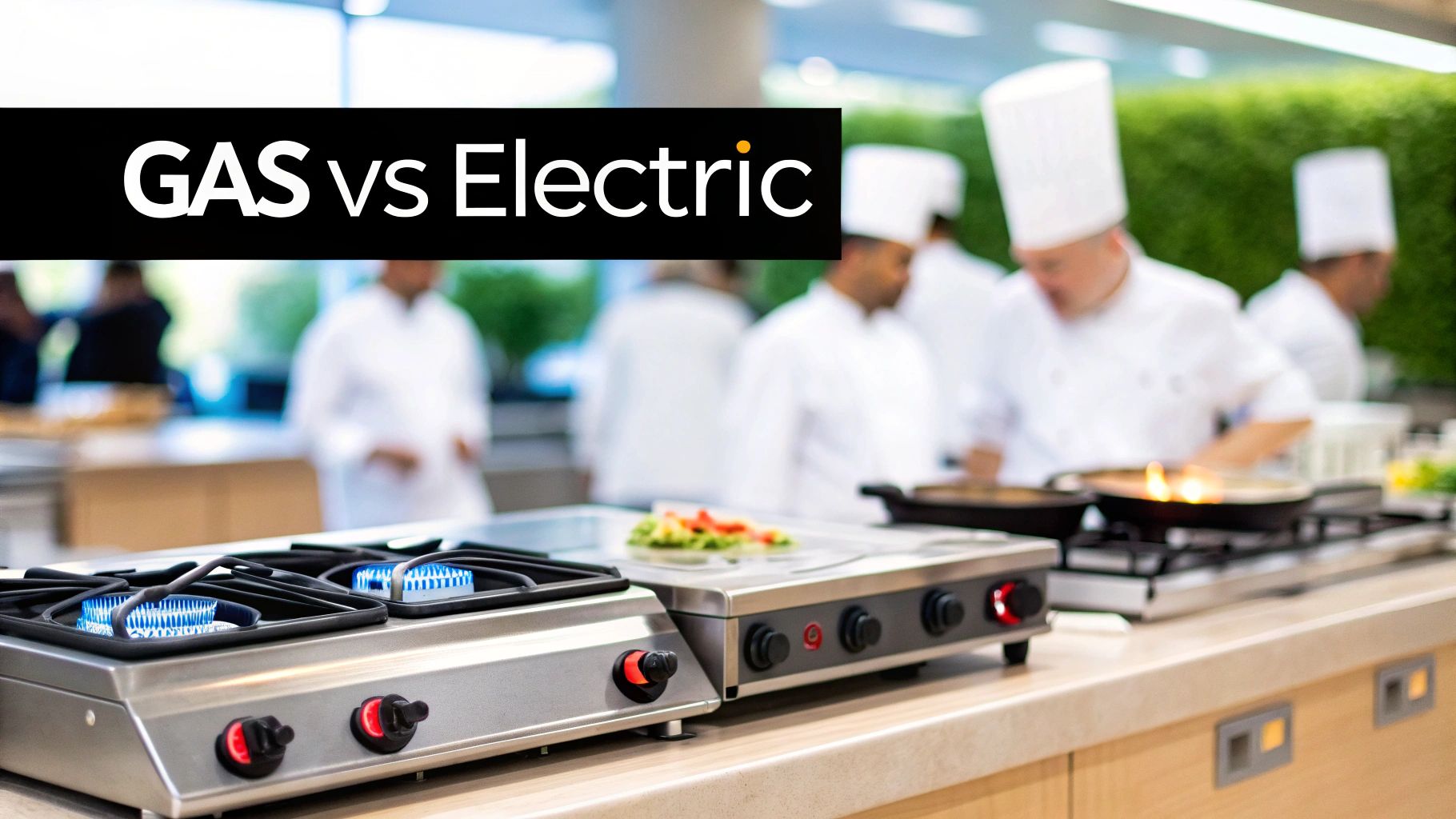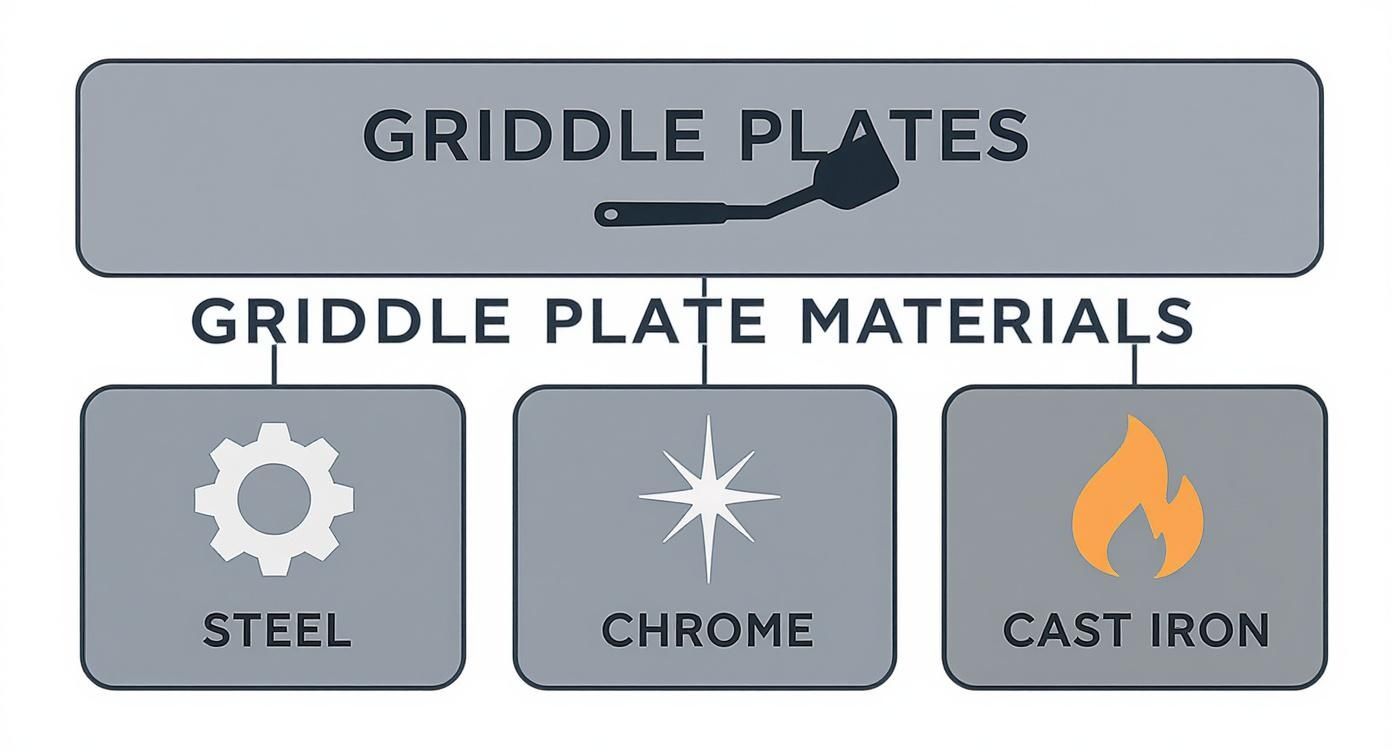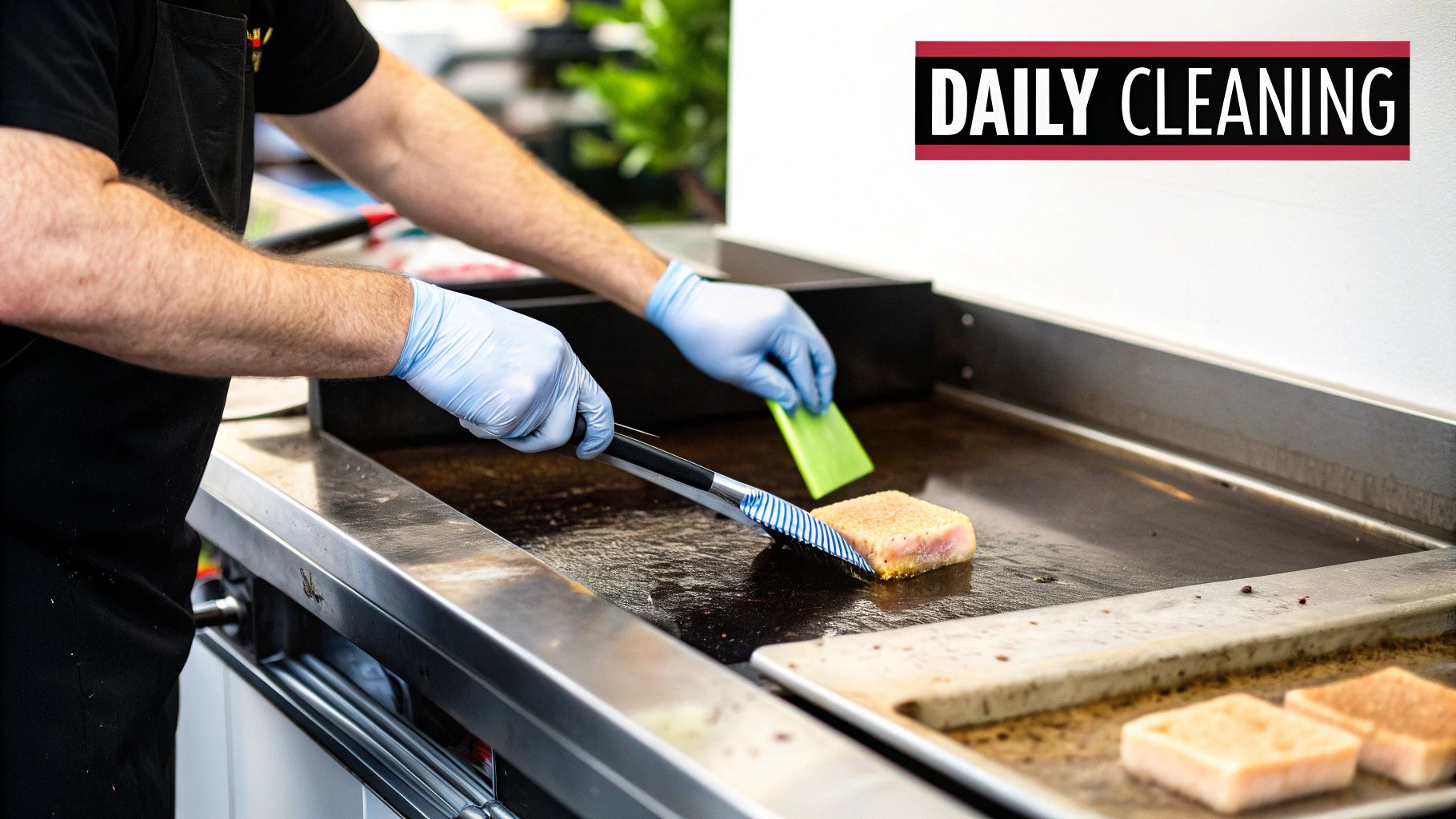
Commercial Griddles: Your Essential Buying Guide
If you've ever worked in a professional kitchen, you know there are a few pieces of equipment that are the absolute workhorses. The commercial griddle is one of them. It's not just a big, flat piece of metal; it’s the heart of the operation in countless diners, burger joints, and high-end restaurants. This is where the action happens.
Understanding the Role of a Commercial Griddle

Think of a commercial griddle as your kitchen's command center. Its whole purpose is to give you a massive, evenly heated surface to cook a lot of food, fast. Forget juggling a dozen frying pans on the range. A griddle lets a single chef fire off multiple orders at once, turning a potentially chaotic service into a smooth, money-making machine.
This is what saves you during the rush. A diner cranking out stacks of pancakes and sizzling bacon for the breakfast crowd? That’s the griddle. A steakhouse searing multiple filets to a perfect medium-rare simultaneously? Griddle again. That ability to push out volume without ever compromising on quality is what makes it such a fundamental piece of gear.
The Foundation of Menu Versatility
The real beauty of a commercial griddle is just how much you can do with it. That single, uninterrupted surface can handle an incredible variety of foods, saving you precious space and cutting down on the pot-and-pan shuffle.
Just look at what one griddle can cover throughout the day:
- Breakfast Powerhouse: It's built for classics like bacon, sausage links, hash browns, and golden-brown French toast.
- Lunch Rush Champion: Perfect for smashing burgers, building Philly cheesesteaks, toasting grilled cheese, and crisping up quesadillas.
- Dinner Service Staple: It gets that perfect, beautiful sear on delicate fish, chicken breasts, and scallops.
This flexibility means one piece of equipment can anchor your entire menu, from the morning rush all the way through dinner service.
A commercial griddle isn't just about cooking more; it's about cooking smarter. By consolidating cooking processes onto one surface, kitchens can improve workflow, reduce ticket times, and maintain consistent food quality across every shift.
A Cornerstone of Kitchen Efficiency
The design behind a commercial griddle is brilliant in its simplicity. It’s engineered for even heat distribution, which means no more surprise hot spots or undercooked food. Every pancake and every burger patty cooks at the same rate, giving you the kind of consistency that keeps customers coming back.
The demand for this kind of reliable equipment is only growing. The global market for commercial cooking equipment, with griddles being a major player, was valued at over USD 11 billion in 2023 and is expected to keep climbing. According to data on commercial cooking equipment market growth on GrandViewResearch.com, this trend shows just how much the foodservice industry relies on high-efficiency gear.
When you invest in a quality griddle, you’re not just buying an appliance—you're investing in the operational backbone of your kitchen.
To put it simply, here’s a quick breakdown of why a commercial griddle is a game-changer for any professional kitchen.
Commercial Griddle Key Advantages at a Glance
| Feature | Benefit for Your Business |
|---|---|
| Large Cooking Surface | Cook multiple orders at once, drastically increasing output during peak hours. |
| Even Heat Distribution | Delivers consistent, reliable results every time, reducing food waste and ensuring quality. |
| Menu Versatility | Supports a wide range of menu items, from breakfast to dinner, maximizing your investment. |
| Improved Workflow | Centralizes cooking tasks, saving space and making your kitchen line more efficient. |
| Durability | Built from heavy-duty materials like stainless steel to withstand the demands of a busy kitchen. |
Ultimately, integrating a commercial griddle is one of the smartest moves a restaurant owner can make to boost both productivity and profitability.
Gas Versus Electric Griddles Explained

Picking between a gas and an electric griddle is one of those foundational choices every kitchen operator has to make. This isn't just about how you power it up; this decision shapes your workflow, hits your utility budget, and ultimately affects the food you serve.
To really get it, let's use an analogy.
Think of a gas griddle as a classic muscle car. The second you turn that knob, you feel it. It roars to life, heats up in a flash, and gives you that instant, powerful response you need for high-speed cooking. It’s built for the chef who needs to react on a dime.
Now, picture an electric griddle as a modern electric vehicle. It’s a quieter, smoother ride. It might take a bit longer to reach its cruising temperature, but once it's there, it maintains that heat with incredible precision and evenness. Perfect for delicate jobs that require a steady hand.
The Power and Precision of Gas Griddles
Gas griddles are the workhorses of high-volume kitchens for a reason: raw power and lightning-fast response. Chefs love them because they can crank the heat for a deep sear on a steak, then dial it back instantly for toasting a bun, all without missing a beat. That kind of speed is a game-changer during a hectic dinner rush.
They also preheat much quicker, meaning you're ready to cook almost immediately. And when you throw a batch of frozen burgers on the flat top, a gas unit’s recovery time—how fast it gets back up to temp—is exceptional. This is a massive plus when you're turning tickets over and over.
The main fuel sources are natural gas and propane. You'll want to dig into our guide comparing natural gas versus propane to figure out which makes more sense for your setup.
If your kitchen is all about speed, volume, and the ability to adapt on the fly, a gas griddle is tough to beat. That immediate control is exactly what a chef needs to command a busy line.
The Consistency and Control of Electric Griddles
While gas brings the heat, electric griddles bring the finesse. Their heating elements are built right into the griddle plate, which means the heat spreads out in a beautifully even pattern. You can say goodbye to those pesky hot spots that sometimes plague gas burners.
This means every single pancake, egg, or piece of delicate fish gets the exact same cooking temperature. If your menu has items that can scorch in a heartbeat, an electric griddle’s rock-solid temperature stability is your best friend.
Sure, they take longer to heat up and cool down, but their ability to lock in a specific temperature is second to none. As a bonus, they tend to make for a cooler kitchen since they don't vent as much ambient heat as gas models.
Comparing Key Operational Factors
So, which one is for you? It really boils down to your kitchen's infrastructure, your menu, and your budget.
- Installation and Utility Access: Gas models need a dedicated gas line and proper ventilation, which can be a hefty upfront investment. Electric griddles just need the right high-voltage outlet, making them a lot more flexible to install.
- Energy Costs: This one is location-dependent. In some areas, natural gas is much cheaper than electricity, but that's not a universal rule. Propane gives you portability for food trucks and catering gigs but can be pricier per BTU.
- Performance for Specific Foods: A burger joint churning out hundreds of patties a day will love the rapid recovery of a gas griddle. A breakfast spot aiming for perfectly golden-brown pancakes will probably get better results from the steady heat of an electric model.
At the end of the day, there’s no single "best" option. It's about matching the tool to the job. Gas delivers raw, responsive power, while electric offers smooth, unwavering consistency.
Choosing the Right Griddle Plate Material
The griddle plate is more than just a piece of metal; it’s the heart of your operation. The material you choose will dictate how food cooks, how heat is managed, and how much time your staff spends cleaning up at the end of a long shift. This decision is a big one, affecting everything from your kitchen's flow to the final quality of your food.
Think of it like choosing the right pan at home. You wouldn't try to sear a steak in a delicate non-stick pan or flip fragile crepes in a heavy cast iron skillet. Each surface has a job it’s best suited for, and commercial griddles are exactly the same.
Steel: The All-Around Workhorse
When in doubt, go with steel. Standard steel griddle plates are the undisputed champions in most commercial kitchens for a good reason. They're tough, versatile, and can take a beating day in and day out, from smashing down burgers to charring vegetables. A steel plate is a reliable partner you can count on.
The key to unlocking its potential is seasoning. This process builds up a protective, non-stick layer (called a patina) that prevents food from sticking and protects the surface from rust. It's a bit of initial work, but it pays off. For a full rundown, check out our guide on how to season a new griddle.
Chrome Top: The Non-Stick Specialist
If steel is the rugged workhorse, chrome is the polished specialist. A chrome-top griddle boasts a mirror-like finish that delivers an incredible non-stick surface from day one. This makes it the perfect choice for delicate items like pancakes, eggs, and fish that tend to stick and fall apart on other surfaces.
Because the chrome surface is non-porous, flavors won't transfer. That means you can cook a piece of salmon right after a batch of pancakes with no taste crossover. Cleanup is also a breeze, often just a quick wipe-down with a soft cloth and water, which saves a ton of time during a busy service.
The trade-off? Chrome needs a little TLC. You absolutely must use non-metallic utensils, as a metal spatula will scratch and ruin that beautiful, functional surface.
The real magic of chrome isn't just its non-stick quality. Its surface is incredibly efficient at radiating heat directly into the food, meaning less heat escapes into your kitchen.
This efficiency hits your bottom line directly. Research on heat transfer has shown that chrome-plated surfaces can slash energy consumption by up to 30% compared to standard steel plates, thanks to their superior heat emissivity. That translates to lower utility bills and a cooler, more comfortable kitchen for your crew. You can learn more about energy-efficient griddles on pgefoodservice.com.
Cast Iron: The Heat Retention King
Last but not least, we have cast iron. While you don't see it as often in modern commercial griddles, it is legendary for one specific trait: unbeatable heat retention. Once a cast iron plate gets hot, it stays hot. This is a massive advantage for high-volume searing, where you're constantly dropping cold food onto the cooktop.
Just like steel, cast iron demands meticulous seasoning to build a non-stick cooking plane and keep rust at bay. It’s a heavier, more traditional option that truly rewards kitchens that are willing to put in the effort to maintain it. Ultimately, picking the right material boils down to your menu, your team's training, and what you prioritize in your daily operations.
Essential Features For Your Next Griddle Purchase

When you're staring down the spec sheet for a new commercial griddle, it's easy to get lost in the details. But once you move past the big stuff like fuel type and plate material, a few key features will make or break your daily grind. Nailing these choices isn't just about buying a piece of equipment; it's a strategic move for a more efficient kitchen and better food.
Think of these features as the engine under the hood. Getting them right means your team is flipping burgers faster, cooking eggs more consistently, and generally having a much smoother service. Let's break down exactly what you should be looking for.
Thermostat Types And Temperature Precision
The thermostat is the brain of your griddle, and its design directly controls how consistent your cooking will be. In the world of commercial griddles, you've really got two main options.
- Snap-Action Thermostats: This is the most basic type, acting like a simple on/off switch. The burners go full blast until the griddle hits the set temperature, then they shut off. Once the surface cools enough, they kick back on at full power. This creates a temperature rollercoaster, sometimes swinging as much as 40°F, which can be a nightmare for delicate foods like pancakes.
- Modulating Thermostats: Here's where you get real control. Instead of just on or off, a modulating thermostat adjusts the flame up or down to keep the temperature steady, often holding it within 15°F of your target. That kind of precision is a game-changer for anything that needs a delicate, even heat.
If your menu relies on consistent, precise temperatures from one end of the cooktop to the other, a modulating thermostat is the only way to go.
Why Griddle Plate Thickness Matters
One of the most critical specs that gets overlooked is the thickness of the griddle plate itself. It’s a common mistake to think they’re all the same, but the reality is that thickness is everything when it comes to heat retention and recovery.
Picture the griddle plate as a battery for heat. A thick plate—the gold standard being 1-inch thick on quality commercial units—stores a huge amount of thermal energy. So when your line cook slaps down a dozen frozen burger patties, a thin plate will instantly lose its heat, steaming the meat instead of searing it.
A heavy-duty, thick plate, on the other hand, has enough heat banked to handle that thermal shock and keep on cooking. That means you get back to searing temperature almost instantly, which is crucial for keeping up with orders during a crazy dinner rush.
Choosing a griddle with a 1-inch thick plate is one of the single best ways to ensure your equipment can keep up with high-volume demands. It's the difference between a griddle that works for you and one you have to wait on.
To make sense of it all, here's a quick breakdown of how these features translate to real-world kitchen performance.
Commercial Griddle Feature Comparison
This table gives you a comparative look at essential features and how they directly impact your kitchen's performance, running costs, and the quality of the food you serve.
| Feature | Impact on Operations | What to Look For |
|---|---|---|
| Thermostat Type | Directly affects cooking consistency. Modulating thermostats provide stable heat for delicate items, while snap-action is more basic. | Modulating thermostats for precision cooking. Snap-action thermostats for budget-conscious, general-purpose use. |
| Plate Thickness | Governs heat retention and recovery time. Thicker plates handle high volume and frozen foods without losing temperature. | A 1-inch thick plate is the industry standard for high-performance, high-volume kitchens. |
| BTU Rating (Gas) | Determines how quickly the griddle heats up and recovers. Higher BTUs are essential for busy operations. | At least 30,000 BTUs per 12 inches of griddle width to keep up with demand. |
| Grease Management | A good system prevents messes, reduces fire risk, and makes cleanup much faster at the end of a long shift. | A wide, deep grease trough and a large, easily removable drip tray. |
Ultimately, choosing the right features comes down to matching the equipment to your menu and your volume. A little extra investment upfront for a thicker plate or a better thermostat pays for itself many times over in saved time and better food.
Power, Grease Management, And Safety
Finally, a few other specs play a huge role in your griddle's day-to-day performance, safety, and ease of use. Don't gloss over these details—they're what separate a good griddle from a great one.
BTUs and Recovery Time: When it comes to gas griddles, the British Thermal Unit (BTU) rating tells you how much raw heating power you're working with. More BTUs mean faster preheating and quicker recovery. You'll want to look for models with at least 30,000 BTUs per 12 inches of cooking surface to make sure your griddle doesn't lag behind during a rush.
Grease Management System: This is non-negotiable. A sloppy grease system is a pain to clean and a serious fire hazard. Look for a wide grease trough that channels runoff effectively and a large drip tray that’s easy for your staff to remove and clean without making a mess.
Splash Guards: These are the raised metal edges around the back and sides of the griddle. They do two crucial things: keep grease from splattering all over your walls and other equipment, and protect your chefs from nasty burns. Taller guards are always better.
Mastering Griddle Maintenance and Cleaning

A commercial griddle is the engine of your kitchen. Like any hard-working engine, it needs regular care to keep firing on all cylinders. Skipping maintenance isn't a small thing—it leads to spotty cooking, weird flavor transfer between dishes, and can seriously shorten the life of your gear.
Consistent cleaning is your best defense. Think of your griddle top like a prized cast iron skillet. When you treat it right, you build up a beautiful non-stick surface that makes cooking a dream and your food taste incredible. If you let it go, burnt-on gunk and carbon take over, ruining that seasoning and making every service a battle against sticking food.
Ultimately, a well-kept griddle is non-negotiable for food safety and a smooth-running kitchen. It guarantees every plate that goes out is cooked on a clean, sanitary surface, letting the real flavors shine through and protecting your hard-earned reputation.
The Art of Seasoning Your Griddle
Before a single burger hits that flat top, the most important thing you can do is season it. This is especially true for steel or cast iron griddles. The process is simple: you apply a super-thin layer of oil and heat it until it starts to smoke. This triggers a chemical reaction called polymerization, creating a tough, protective, and naturally non-stick cooking surface.
This initial seasoning is the foundation for years of killer performance, but it’s not a one-and-done deal. Every time you cook with oil or fatty foods, you're adding to that protective layer. A solid daily cleaning routine helps preserve this patina, making each shift a little smoother than the one before.
Your Daily Cleaning Checklist
The real secret to a griddle that lasts forever and performs flawlessly is daily cleaning. It’s what stops that nasty, stubborn buildup of carbonized grease that can taint food and wreck the griddle plate. This routine doesn't need to be a huge production, but it absolutely has to happen every single day.
Just follow these steps at the end of every service:
- Scrape It Hot: While the griddle is still warm (not scorching), grab a griddle scraper and push all the food bits and extra grease into the trap.
- Add Warm Water: Pour a little warm water on the surface. You'll see it steam up, which is perfect for lifting off any stubborn, cooked-on grime.
- Gentle Scrub: Use a griddle pad or brick to scrub the surface in a circular motion. This gets rid of the loosened gunk without stripping away all that beautiful seasoning you've built.
- Wipe and Dry: Use a clean, damp rag to wipe the surface, then follow up with a dry cloth or paper towels. Getting it completely dry is key to preventing rust.
- A Light Coat of Oil: Finish by wiping on a very thin layer of cooking oil. This protects the surface overnight and gets it ready for the next day.
A disciplined cleaning routine is the single best way to protect your investment. A five-minute cleanup at the end of the night saves you from hours of brutal scrubbing down the road and keeps your griddle ready for action.
If you're looking for more pro tips, check out our complete guide on how to clean a flat top griddle. It breaks down different methods to keep your equipment in prime condition.
Managing The Grease Trap
That grease trap is easy to forget, but you can't afford to. A full trap isn't just a mess waiting to happen; it’s a serious fire hazard. Make emptying and cleaning it a mandatory part of your closing duties every single day.
It’s a quick job. Just slide the tray out, get rid of the cooled grease (make sure you follow local health codes), and wash the tray with hot, soapy water. A clean trap means better drainage, fewer smells, and a much safer kitchen for everyone. By making these simple habits part of your routine, your griddle will remain a reliable workhorse for years to come.
Your Commercial Griddle Questions, Answered
When you're shopping for a new griddle, the questions can pile up fast. How big? What kind of fuel? Which controls make sense for my menu? Getting the right answers means you can choose a piece of equipment that will be a workhorse, not a headache.
Let's dive into some of the most common questions we hear from chefs and restaurant owners.
Sizing and Cooking Surface Questions
One of the first questions is always, "How big of a griddle do I really need?" The answer comes down to your busiest rush. A solid rule of thumb is to plan for about 12 inches of griddle width for every cook who will be using it during peak hours. A high-volume diner might need a 48-inch or even a 60-inch model to keep the orders flying, while a small cafe could easily get by with a 24-inch countertop unit.
Another common point of curiosity is temperature zones. Many larger griddles have multiple thermostat controls, which is a huge advantage. This lets you create different heat zones on one flat top, so you can sear burgers on high heat on one side while gently toasting buns on the other. It's like having multiple pans in one, boosting efficiency without cluttering your cookline.
Operational and Power Questions
"Can I just hook up a propane tank to any gas griddle?" This is a crucial one, especially for food trucks or caterers. While many modern gas griddles are "field convertible," this isn't a DIY job. A conversion must be done by a qualified technician using the manufacturer's specific kit to be safe and effective. Don't ever assume a griddle can run on propane; always check the specs first.
"What's the real difference between a thermostatic and a manual griddle?" We've touched on this, but it's a key decision. Thermostatic griddles use a thermostat to maintain a precise temperature, making them perfect for delicate items like pancakes and eggs where consistency is king. Manual griddles have simpler low, medium, and high controls, which is great for hardy, high-volume foods like burgers and cheesesteaks where you just need raw power.
Choosing the right controls isn't about which is "better." It’s about matching the tool to the job. Thermostatic models give you precision; manual models offer simple, brute-force heat.
Finally, we often get asked, "How often do I need to re-season my griddle?" The initial seasoning is the big one. After that, you're constantly building and maintaining that non-stick surface with every cook and proper daily cleaning. A full re-seasoning—where you strip the surface bare and start over—is only necessary if the seasoning gets damaged from harsh detergents or if rust appears. If you take good care of it daily, you might never need to do a full strip-down.
Ready to find the perfect powerhouse for your kitchen? Explore a complete range of high-performance commercial griddles at Griddles.com. We offer top-tier equipment with free, fast shipping to get your line cooking. See our full catalog at https://griddles.com.
